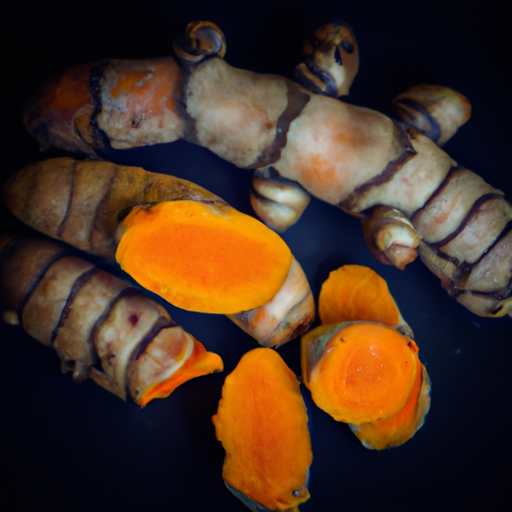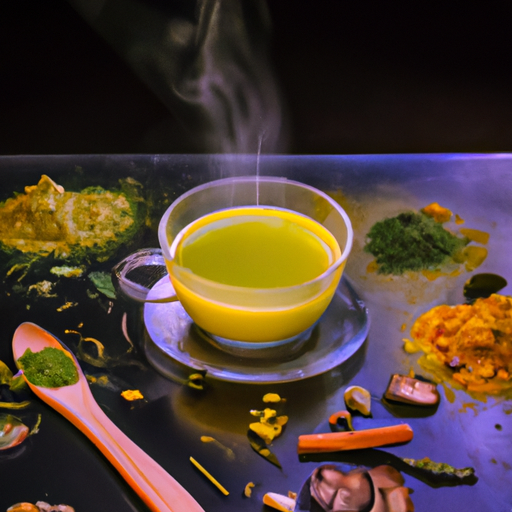Did you know that chronic inflammation is linked to numerous health conditions, including heart disease, cancer, and autoimmune disorders? It’s a staggering statistic that highlights the importance of managing inflammation in our bodies.
Thankfully, nature provides us with a powerful ally in the form of turmeric, a vibrant yellow spice commonly found in Indian cuisine. Turmeric has gained popularity for its potent anti-inflammatory properties, which have been harnessed for centuries in traditional medicine.
But how long does it take for turmeric to work as an anti-inflammatory? In this article, we will explore the science behind turmeric’s effectiveness, the factors that influence its action, and the time frame for you to start experiencing its benefits. We will also provide tips on maximizing the anti-inflammatory benefits of turmeric and discuss potential side effects and precautions.
So, let’s dive in and uncover the secrets of this golden spice!
Key Takeaways
- Turmeric’s effectiveness as an anti-inflammatory can vary depending on dosage, overall health, severity of inflammation, and specific condition being treated.
- It may take four to eight weeks to see the full benefits of turmeric as an anti-inflammatory.
- Consistent use over time is necessary to see significant results.
- Healthcare professionals can provide personalized advice and guidance based on individual needs and medical history.
Understanding Turmeric’s Anti-Inflammatory Properties
So, how long does it take for turmeric to work its anti-inflammatory magic?
Turmeric has been used for centuries in traditional medicine for its various health benefits, including its potential anti-inflammatory properties. Research suggests that curcumin, the active compound in turmeric, may help reduce chronic inflammation and manage inflammatory diseases.
Numerous studies have examined the effect of turmeric on chronic inflammation, and the results are promising. Curcumin has been found to inhibit several molecules involved in the inflammatory response, such as cytokines and enzymes. These molecules play a crucial role in triggering and sustaining inflammation. By targeting them, curcumin may help regulate the inflammatory process and alleviate symptoms associated with inflammatory diseases.
However, it’s important to note that the time it takes for turmeric to work as an anti-inflammatory can vary depending on various factors. These factors include the dosage, the individual’s overall health, the severity of the inflammation, and the specific condition being treated. Some studies have shown significant improvements in inflammation markers within a few weeks of turmeric supplementation, while others may take longer to observe noticeable effects.
Transitioning into the subsequent section about the bioavailability of turmeric, it’s important to understand how our bodies absorb and utilize curcumin to fully harness its anti-inflammatory potential.
The Bioavailability of Turmeric
Turmeric’s effectiveness as an anti-inflammatory agent is influenced by its bioavailability. Bioavailability refers to the degree and rate at which a substance is absorbed into the bloodstream and becomes available for the body to use. In the case of turmeric, its bioavailability factors play a crucial role in determining how quickly and effectively it can work as an anti-inflammatory.
One of the key factors affecting turmeric’s bioavailability is its poor solubility in water. This means that when consumed in its raw form, turmeric is not easily absorbed by the body. However, studies have shown that combining turmeric with black pepper can significantly enhance its absorption rate. Black pepper contains a compound called piperine, which has been found to improve the bioavailability of turmeric by up to 2000%.
Additionally, turmeric’s bioavailability can be increased by consuming it with fats. This is because turmeric is fat-soluble, meaning it is better absorbed by the body when consumed alongside dietary fats. For example, incorporating turmeric into a meal that contains olive oil or coconut milk can enhance its absorption and effectiveness as an anti-inflammatory.
Turmeric’s bioavailability factors, such as solubility and absorption rate, play a critical role in determining its effectiveness as an anti-inflammatory agent. Combining turmeric with black pepper and consuming it with fats can significantly improve its bioavailability. These factors will be further explored in the subsequent section about the factors influencing turmeric’s effectiveness.
Factors That Influence Turmeric’s Effectiveness
To truly maximize the power of turmeric, you need to understand the factors that can dramatically boost its effectiveness like never before! One important factor to consider is the bioavailability of turmeric. Bioavailability refers to the extent to which a substance can be absorbed and used by the body. In the case of turmeric, its bioavailability can be influenced by various factors such as the way it’s prepared and consumed.
For example, combining turmeric with black pepper or fats like coconut oil can enhance its absorption. Additionally, the dosage of turmeric also plays a crucial role in its effectiveness. Research suggests that higher doses of curcumin, the active compound in turmeric, are more likely to produce therapeutic effects. However, it’s important to note that the optimal dosage may vary depending on individual factors such as age, health condition, and the specific health benefit being targeted.
By understanding these bioavailability factors and following dosage recommendations, you can ensure that you’re getting the most out of turmeric. This sets the stage for discussing the time frame for turmeric to show results.
Time Frame for Turmeric to Show Results
One key factor to consider when using turmeric is the amount of time it typically takes to see noticeable results. Turmeric is known for its anti-inflammatory properties, but the time frame for it to show its effectiveness can vary.
It is important to understand that turmeric isn’t a quick fix and may require consistent use over a period of time to see significant results.
The effectiveness of turmeric as an anti-inflammatory agent depends on various factors such as the individual’s overall health, the severity of the inflammation, and the dosage used. Some individuals may experience relief within a few days, while others may need to use turmeric for several weeks or even months before noticing a difference.
Research suggests that it can take anywhere from four to eight weeks to see the full benefits of turmeric as an anti-inflammatory. This is because the active compound in turmeric, curcumin, needs time to accumulate in the body and exert its effects on inflammation.
The time frame for turmeric to work as an anti-inflammatory can vary depending on individual factors and the severity of the inflammation. It’s important to be patient and consistent with turmeric usage to experience its full benefits.
In the next section, we’ll explore tips for maximizing the anti-inflammatory benefits of turmeric without writing ‘step’.
Tips for Maximizing the Anti-Inflammatory Benefits of Turmeric
If you’re looking to enhance the anti-inflammatory benefits of turmeric, there are some helpful tips to consider. Maximizing the absorption of turmeric is key to experiencing its full potential. Here are four tips to help you get the most out of this powerful spice:
-
Combine with black pepper: Adding black pepper to your turmeric can significantly increase its absorption. Piperine, a compound found in black pepper, enhances the bioavailability of curcumin, the active ingredient in turmeric.
-
Consume with fat: Turmeric is fat-soluble, meaning it’s better absorbed when consumed with a source of fat. You can pair it with healthy fats like coconut oil, olive oil, or avocado to maximize its absorption.
-
Heat it up: Heat can also boost the absorption of curcumin. Cooking turmeric in dishes or incorporating it into warm beverages can enhance its anti-inflammatory effects.
-
Consider turmeric dosage: While there’s no standard dosage for turmeric, higher doses may be more effective in reducing inflammation. Consult with a healthcare professional to determine the appropriate dosage for your specific needs.
By following these tips, you can maximize the anti-inflammatory benefits of turmeric. However, it’s important to be aware of potential side effects and precautions associated with its use.
Without further ado, let’s explore the potential side effects and precautions of turmeric.
Potential Side Effects and Precautions
Let’s now delve into the potential side effects and precautions of turmeric, so you can stay informed about this powerful spice. While turmeric is generally safe for most people when consumed in small amounts as a spice in food, there are some potential risks and considerations to keep in mind.
One possible side effect of turmeric is gastrointestinal distress, including stomach upset, bloating, and diarrhea. These symptoms are more likely to occur when turmeric is taken in high doses or as a supplement. Additionally, turmeric may interact with certain medications, such as blood thinners, and can increase the risk of bleeding. It is important to talk to your healthcare provider if you are taking any medications or have any underlying health conditions before incorporating turmeric into your routine.
Dosage recommendations for turmeric vary depending on the specific health condition being addressed. However, most studies have used doses ranging from 500 to 2,000 milligrams of curcumin, the active compound in turmeric. It is always best to start with a lower dose and gradually increase as needed, under the guidance of a healthcare professional.
While turmeric offers many potential health benefits, it is important to be aware of the potential side effects and precautions. Consulting with a healthcare professional is essential in order to determine the appropriate dosage and ensure that turmeric is safe for your individual circumstances.
Consultation with a Healthcare Professional
After discussing the potential side effects and precautions of turmeric as an anti-inflammatory, it’s important to emphasize the significance of consulting with a healthcare professional before incorporating it into your routine.
While turmeric is generally considered safe for most people, it may interact with certain medications or medical conditions. Your healthcare provider can provide personalized advice and guidance based on your specific needs and medical history.
During a consultation, your healthcare professional may discuss medication alternatives and natural remedies that can complement or replace the use of turmeric as an anti-inflammatory. They can provide information on other herbs or supplements that have anti-inflammatory properties and are known to interact less with medications. Additionally, they can guide you on the proper dosage and duration of using turmeric or any other alternative treatment.
By seeking professional advice, you can ensure that you’re making informed decisions about your health and well-being. It’s essential to have open and honest communication with your healthcare provider to optimize the effectiveness and safety of any treatment plan. They can help you weigh the benefits and risks of turmeric or suggest suitable alternatives that align with your goals and medical needs. Remember, your healthcare provider is your best resource when it comes to making decisions about your health.
Frequently Asked Questions
Can turmeric be used as a substitute for traditional anti-inflammatory medications?
Turmeric can serve as a natural alternative to traditional anti-inflammatory medications, but it’s important to consider the long-term effects. While it may take time to see results, research suggests its effectiveness in reducing inflammation.
Is it safe to consume turmeric in large amounts to accelerate its anti-inflammatory effects?
Consuming large amounts of turmeric for its anti-inflammatory effects is not recommended as it can lead to potential side effects. It is important to follow the recommended turmeric dosage to avoid any adverse reactions.
Are there any specific conditions or diseases where turmeric may not be effective as an anti-inflammatory?
Turmeric’s anti-inflammatory benefits are widely known, but ironically, it may not be effective for specific conditions or diseases. Its effectiveness varies depending on the individual and the severity of the condition.
Can turmeric be used topically as an anti-inflammatory treatment?
Turmeric can be used topically as an anti-inflammatory treatment for skin conditions. The effectiveness of turmeric cream varies depending on the individual and the specific condition, but it has shown promising results in some studies.
Are there any known drug interactions with turmeric that could affect its anti-inflammatory properties?
I will discuss the drug interactions with turmeric and the safety of consuming it in large amounts. It is important to be aware of potential interactions with medications and consult a healthcare professional before using turmeric as an anti-inflammatory.
Conclusion
In conclusion, turmeric’s anti-inflammatory properties are well-documented and have been used for centuries in traditional medicine. However, the effectiveness of turmeric can vary depending on factors such as bioavailability and individual differences. While some people may experience quick results, for others, it may take longer to see the full benefits. It’s important to consult with a healthcare professional for personalized guidance.
Just like a slow-burning flame, turmeric’s healing power may take time to fully ignite, but the wait is worth it for its potential anti-inflammatory benefits.










